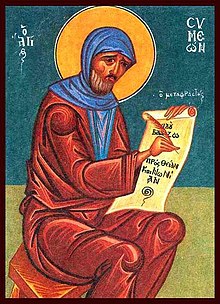| Saint Symeon the Metaphrast | |
|---|---|
 | |
| Venerable, Hagiographer, Logothete | |
| Born | 886-912 (900) Constantinople (modern-day Istanbul, Turkey) |
| Residence | Constantinople |
| Died | November 28, 987 Constantinople |
| Honored in | Eastern Orthodox Church |
| Canonized | 11th century, Constantinople by Eastern Orthodox Church |
| Feast | November 9/November 22 |
| Attributes | Pen, Scroll, Religious habit |
| Major works | Menologium |
Symeon or Simeon (died c. 1000), distinguished as Symeon Metaphrastes (Latin) or Symeon the Metaphrast (Ancient Greek: Συμεών ὁ Μεταφραστής, Symeṓn ho Metaphrastḗs), was a Byzantine writer and official regarded as a saint in the Eastern Orthodox Church. His feast day is celebrated on 9 or 28 November. He is best known for his 10-volume Greek menologion, a collection of saints' lives.
Life
About Symeon's life few details are known. He lived in the second half of the 10th century. Ephrem Mtsire puts him at the peak of his career in the sixth year of Basil II (982). Yahya of Antioch also makes him a contemporary of Basil II and Patriarch Nicholas II of Constantinople (984–991). In the 15th century, Mark Eugenikos wrongly called Symeon a megas logothetes. The hagiographer actually lived a generation later than the historian Symeon Logothete.
Works
Symeon wrote mainly hymnody and hagiography. He composed kanones, stichera and a hymn to the Trinity. He also compiled excerpts of the church fathers, particularly Basil the Great. His most important work by far, however, is the menologion, which Albert Ehrhard labelled "a revolution in the field of hagiography". According to tradition, it was commissioned by Basil II.
Symeon's menologion is a product of the encyclopedism characteristic of the Macedonian Renaissance. He did not merely collect and arrange pre-existing saint's lives, but also reworked them, standardizing their language and embellishing their rhetorical style to bring them in line with the Atticism of the day. His nickname comes from this act of metaphrasis. The content of the lives was not altered, however, and historical errors were left intact. Symeon arranged them according to their feast days in the Eastern Orthodox liturgical calendar. There are about 150 distinct lives.
For his menologion, Symeon received praise from Nikephoros Ouranos and Michael Psellos addressed to him an encomium. It was widely read in monasteries. The standard edition came in ten volumes. Numerous illuminated copies were produced in the 11th century. Working independently, Father Delehaye and Albert Ehrhard compiled works attributed to Symeon. They were at a loss for the provenance of some of his materials and their relation to other standard hagiographies. In particular, Delehaye found that Symeon or his immediate sources sparsely added materials of their own drawn from other places.
Some orthodox prayers of preparation before Holy Communion and prayers of thanksgiving after Holy Communion were composed by him.
Veneration
Venerable Symeon the Metaphrast is venerated in the Eastern Orthodox Church. Michael Psellos compiled Symeon's biography (c. 1050) and he composed a liturgical office for him.
References
- ^ Kazhdan, Alexander; Ševčenko, Nancy Patterson (1991). "Symeon Metaphrastes". In Kazhdan, Alexander (ed.). The Oxford Dictionary of Byzantium. Oxford and New York: Oxford University Press. ISBN 0-19-504652-8.
- ^ Cross, F. L.; Livingstone, E. A., eds. (2009) . "Simeon Metaphrastes, St (fl. c. 960)". The Oxford Dictionary of the Christian Church (3rd rev. ed.). Oxford University Press.
- ^ James Carleton Paget (2010). Jews, Christians and Jewish Christians in Antiquity. Mohr Siebeck. pp. 212ff. ISBN 978-3-16-150312-2. Retrieved 13 November 2012.
- Per Kazhdan and Ševčenko, his dates have generated some controversy. Mark Eugenikos places his birth in the reign of Leo VI the Wise, which would give him an improbably long life. Some modern scholars have moved his life forward to the 11th century, but this contradicts both Ephrem and Yahya.
- Herbermann, Charles, ed. (1913). "Symeon Metaphrastes" . Catholic Encyclopedia. New York: Robert Appleton Company.
- Delehaye, Preface to the "Synaxarium Eccles. Cp.", Propylæum to the Acta Sanctorum for November, lix-lxvi.
- "Каноны и молитвы для подготовки к Таинствам Исповеди и Святого Причащения - Молитвослов". azbyka.ru (in Russian). Retrieved 2022-04-15.
- "Благодарственные молитвы по Святом Причащении - Молитвослов". azbyka.ru (in Russian). 2014-05-17. Retrieved 2022-04-15.
- "Преподобный Симео́н Метафраст". Православный Церковный календарь (in Russian). Retrieved 2022-04-15.
- "СИМЕОН МЕТАФРАСТ - Древо". drevo-info.ru (in Russian). Retrieved 2022-04-15.
Further reading
- Leo Allatius, De Symeonum scriptis diatriba (Paris, 1664)
- Ferdinand Hirsch, Byzantinische Studien, pp. 303–355 (Leipzig, 1876)
- Albert Ehrhard, Die Legendensammlung des Symeon Metaphrastes (Rome, 1897)
- Römische Quartalschrift (1897), pp. 67205 and 531-553
- Hippolyte Delehaye, "La vie de saint Paul le Jeune et la chronologie de Metaphraste (1893)
- Delehaye, Hippolyte (1911). "Symeon Metaphrastes" . Encyclopædia Britannica. Vol. 26 (11th ed.). p. 285.
- Analecta Bollandiana, xvi. 312-327 and xvii. 448-452.
- Christian Høgel: Symeon Metaphrastes. Rewriting and Canonization (Copenhagen 2002)